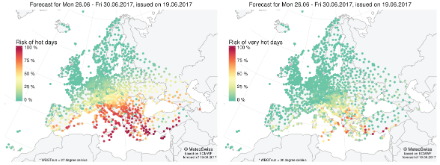Service Navigation
Search
Environmental heating is a growing challenge for our community and problems are already experienced by millions of Europeans during summertime and aggravated during heat waves or under specific occupational settings. In addition to the well-known health risks related to severe heat stress, a number of studies have confirmed significant loss of productivity due to hyperthermia. Climate change and especially rising temperatures will cause increasing heat stress at the workplace. It is hence crucial to develop strategies to mitigate the detrimental health and societal effects of these environmental changes.
HEAT-SHIELD is a EU-funded Horizon 2020 (Grant agreement no. 668786) inter-sectoral project dedicated to improve heat resilience of European workers. The main aim is to provide expertise and guidance to the European community ranging from the individual citizen to public and private policy makers to implement methods and procedures that may secure health and productivity in the face of present and future climatic heat scenarios. Within HEAT-SHIELD the effects across five strategic industries (transport, construction, manufacturing, tourism and agriculture) representing approximately 50% of the work force in Europe are explored. Several field studies are conducted to identify how implementation of better knowledge on solutions will help workers and benefit human health, industrial productivity and the local economy.
The project has a clear multi-disciplinary aspect. There are bio-meteorologists and human physiologists from several research institutions (e.g. University of Florence, University of Copenhagen, University of Ljubljana, University of Thessaly, Loughborough University, EMPA), policy makers (Dutch National Health Service and UK National Health Service), private companies (ACCIONA from Spain, Odelo from Slovenia, Center for Technology Research and Innovation from Cyprus and Karditsa Travel Bureau from Greece) and organizations of the civil society sector (Age UK and Tuscany Centre of Injuries & Occupational Diseases in Italy). The role of MeteoSwiss is to provide the meteorological and climatological information that will be further combined and used in the different stages of the project and case studies.
Heat stress index
There are many indices in the literature to quantify heat stress. Within HEAT-SHIELD, the wet bulb globe temperature (WBGT) has been selected as the heat stress index, since it is the most widely-used index for working people, it can be calculated from basic meteorological parameters and it is easily interpretable and adjustable following international standards. WBGT is obtained for two types of environmental settings depending on the place where the workers carry out their activities: 1) in the shade (obtained from temperature and humidity, also applicable to indoors activities) and 2) in the sun (including additionally solar radiation and wind speed). Relevant WBGT thresholds have been adapted within HEAT-SHIELD for European workers associated to working time per hour and water intake recommendations depending on different working loads (light, moderate, heavy and very heavy work) and individual factors of the worker (acclimatized or unacclimatized). For instance, WBGT above 27°C implies high heat stress risk for unacclimatized employees doing moderate work, and the international standards advice to reduce working time to a maximum of 15 minutes per hour and intake of at least 1 liter of water.
Climate change projections of heat stress
Long-term heat stress projections are obtained by combining the comprehensive EURO-CORDEX regional climate model ensemble with a bias correction technique. The latter is also used to bridge the spatial gap between the modelled (at approximately 50 and 12km) and station data, i.e. it is used as downscaling technique. The regional climate models are first evaluated in terms of their ability to represent the meteorological parameters with respect to observations in a historical reference period. Second, the bias correction method is assessed in this multi-variate context.
Climate change projections of heat stress show that heat stress will increase by 1.5-4.5°C (depending on the emission scenario) until the end of the century over the entire European continent. This will lead to an increase of the number of summer days with high heat stress risk, which for unacclimatized workers active in the sun might reach more than 35 summer days in large parts of southern and central Europe, including Switzerland (Fig.1). The Mediterranean coast and Spain will experience the highest frequency of high heat stress risk, with more than half of the summer days. These results will be further exploited within HEAT-SHIELD in order to produce vulnerability maps based on the combination of heat stress projections with demographic data such as, gender and age of workers in Europe.

Sub-seasonal forecasting system for detecting heat stress
The HEAT-SHIELD short-term climate forecast for heat stress is based on the extended range ensemble forecast system of the European Centre for Medium-Range Weather Forecasts (ECMWF), providing an outlook for the upcoming six weeks. As for the climate change analysis, a downscaling and bias correction step is established between the model and the station data. To assess the quality of heat-risk forecasts, a probabilistic skill evaluation of the simulated atmospheric variables from past re-forecasts (hindcasts) using several metrics has been performed. The verification shows that forecasts of summer WBGT are better than naïve predictions based on climatology for lead times up to two to three weeks.
A prototype of the early-recognition system for heat stress is working operationally on the project website and has been combined with a short-range forecast system (5-days forecasts) for Tuscany. The forecast is issued twice a week, and for each forecast week European maps are made available showing the probability for WBGT (sun conditions) threshold exceedances. In particular, the probabilities of exceeding WBGT thresholds of 27°C (hot days) and 30°C (very hot days) are shown for around 1800 European stations (Figure 2). This sub-seasonal forecasting system will be further developed with the input from stakeholders and case studies in the next phase of the project.
